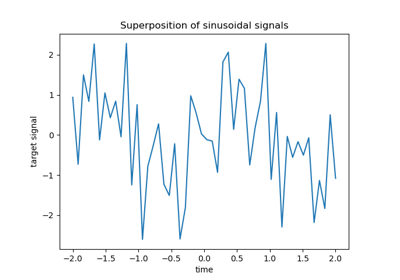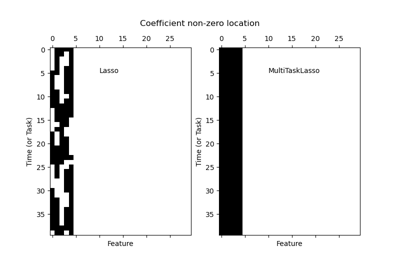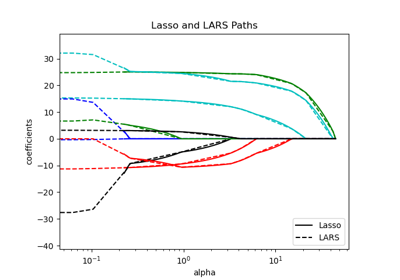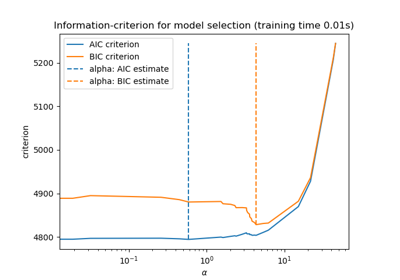Note
Go to the end to download the full example code. or to run this example in your browser via JupyterLite or Binder
Lasso on dense and sparse data#
We show that linear_model.Lasso provides the same results for dense and sparse data and that in the case of sparse data the speed is improved.
# Authors: The scikit-learn developers
# SPDX-License-Identifier: BSD-3-Clause
from time import time
from scipy import linalg, sparse
from sklearn.datasets import make_regression
from sklearn.linear_model import Lasso
Comparing the two Lasso implementations on Dense data#
We create a linear regression problem that is suitable for the Lasso, that is to say, with more features than samples. We then store the data matrix in both dense (the usual) and sparse format, and train a Lasso on each. We compute the runtime of both and check that they learned the same model by computing the Euclidean norm of the difference between the coefficients they learned. Because the data is dense, we expect better runtime with a dense data format.
X, y = make_regression(n_samples=200, n_features=5000, random_state=0)
# create a copy of X in sparse format
X_sp = sparse.coo_matrix(X)
alpha = 1
sparse_lasso = Lasso(alpha=alpha, fit_intercept=False, max_iter=1000)
dense_lasso = Lasso(alpha=alpha, fit_intercept=False, max_iter=1000)
t0 = time()
sparse_lasso.fit(X_sp, y)
print(f"Sparse Lasso done in {(time() - t0):.3f}s")
t0 = time()
dense_lasso.fit(X, y)
print(f"Dense Lasso done in {(time() - t0):.3f}s")
# compare the regression coefficients
coeff_diff = linalg.norm(sparse_lasso.coef_ - dense_lasso.coef_)
print(f"Distance between coefficients : {coeff_diff:.2e}")
#
Sparse Lasso done in 0.105s
Dense Lasso done in 0.037s
Distance between coefficients : 1.01e-13
Comparing the two Lasso implementations on Sparse data#
We make the previous problem sparse by replacing all small values with 0 and run the same comparisons as above. Because the data is now sparse, we expect the implementation that uses the sparse data format to be faster.
# make a copy of the previous data
Xs = X.copy()
# make Xs sparse by replacing the values lower than 2.5 with 0s
Xs[Xs < 2.5] = 0.0
# create a copy of Xs in sparse format
Xs_sp = sparse.coo_matrix(Xs)
Xs_sp = Xs_sp.tocsc()
# compute the proportion of non-zero coefficient in the data matrix
print(f"Matrix density : {(Xs_sp.nnz / float(X.size) * 100):.3f}%")
alpha = 0.1
sparse_lasso = Lasso(alpha=alpha, fit_intercept=False, max_iter=10000)
dense_lasso = Lasso(alpha=alpha, fit_intercept=False, max_iter=10000)
t0 = time()
sparse_lasso.fit(Xs_sp, y)
print(f"Sparse Lasso done in {(time() - t0):.3f}s")
t0 = time()
dense_lasso.fit(Xs, y)
print(f"Dense Lasso done in {(time() - t0):.3f}s")
# compare the regression coefficients
coeff_diff = linalg.norm(sparse_lasso.coef_ - dense_lasso.coef_)
print(f"Distance between coefficients : {coeff_diff:.2e}")
Matrix density : 0.626%
Sparse Lasso done in 0.190s
Dense Lasso done in 0.927s
Distance between coefficients : 8.65e-12
Total running time of the script: (0 minutes 1.330 seconds)
Related examples




